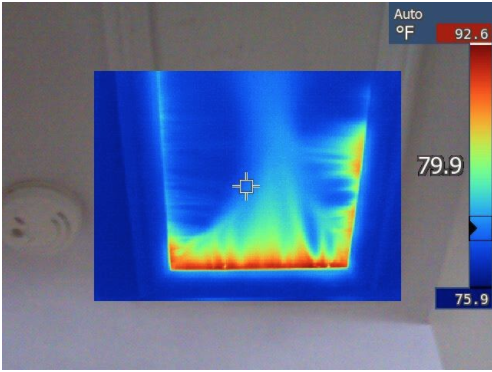1 min read
Riding the Renovation Rollercoaster: The Emotions Behind a Remodel
Every home remodeling journey comes with its own set of emotions, and no project is without its ups and downs. After remodeling homes in the greater...

One of the most cost efficient ways to lower your heating and cooling costs is adding insulation to your home’s building envelope (i.e. the walls, slab and roof that protect your home from the outside.)
Insulation is used to keep heat from flowing through a building envelope. In the winter, insulation helps to reduce heat loss by making it more difficult for heat to flow toward the cold outdoors. Equally, during the hot summer, it helps keep the heat out of your interior environment which is kept cool for your comfort.
A common problem in many homes is air infiltration around windows and external doors. The effectiveness of insulation that has been installed can be negated because the heat will find its way out via window frames, doors that do not have proper seals, or other cracks and crevices that are not properly air sealed.
The photo below is an infrared photo that shows the energy being lost around the attic access opening in a home. This was taken on a summer day and you can see how the heat is leaking out of this opening. Who knew!
Consumers Energy and DTE offer free in-home energy assessments that, while not as thorough as a complete energy audit, they can also help to find where you can save money on your energy bill.

Insulating and air sealing your home are two things you can do to make your home significantly more energy efficient. Having an energy audit can help you make a plan and you’ll get even better results. While adding insulation and air sealing can cost thousands of dollars, there are programs like Michigan Saves that can help finance the work. In addition both DTE and Consumers Energy offer rebates on insulation and many homeowners will find that the resulting energy savings more than offsets the monthly payment. Your house will be significantly more comfortable and there won't be cold rooms in the winter and warm rooms in the summer.
You may have heard about R-value. We won't get into how this is calculated but essentially the R-value measures a material’s resistance to heat flow. So the higher the R-value, the better the material is for insulation purposes. The amount of insulation or R-Value you will need depends on many factors, including:
Where you live (i.e. the climate of your location)
What part of the house you’re insulating
The type of heating and cooling system installed at your home
How it is installed
The importance of indoor air quality to you and your family
The type of insulation you use
Your budget
In new construction, we recommend that you get the best insulation package available. It will be a larger up-front cost, but it will pay out in the long run with lower energy bills and a more comfortable home. In an existing home, it usually makes sense to upgrade or install insulation when you’re replacing siding or putting on a new roof.
There are different types of material options that can be used for home insulation. Fiberglass, mineral wool, rigid foam board, and cellulose are common insulation materials, but for this blog post, we’re going to focus on spray polyurethane foam or SPF.
SPF is a type of insulation that is exactly what it sounds like -- it's sprayed into place. It’s actually a heat-activated polymer that is made by combining two ingredients using special equipment onsite. A chemical reaction takes place and the mixture is sprayed through a heated hose causing the liquid to turn to foam which eventually hardens in place.
Here in Michigan, SPF insulation is usually applied in these areas of your home:
Basement bonds/rim joists
In a crawlspace, or in an attic
Underside of roof decks for a hot roof without exterior rigid insulation
Vapor control layer in basement wall applications
Overhangs or cantilevers
Spray polyurethane foam is becoming a very popular option for insulation and there are two types: Open-cell and Closed-cell spray foam.
Open-cell Spray Foam
Open-cell spray foam is the lighter and less dense option. It is usually the lesser expensive of the two but it also has less insulation power, ie. a lower R value. The cells are open creating a softer, more flexible foam. Open-cell foam expands 3 times more than closed-cell foam and thus, for most installations, only one application is needed. Because it expands so much, closed-cell foam is great for getting into hard-to-reach areas.
Closed-cell spray foam is more expensive; however, it is denser and can provide more rigid support to certain structures. It is resistant to cracking at junctions with other materials, unlike open-cell foam. Because it is less permeable, it can also act as a water vapor barrier. This also means that dust or other allergens are less able to enter your home as well. For families that have allergy sufferers, this could lead to better health. However, it’s important to note that if the chemicals are not mixed correctly, there can be a danger of chemical odors and other health problems for the occupants. Closed-cell spray foam can also keep insects, birds, squirrels and other pests from creating nests or gaining access to your home.
Not all spray foam is created equal. Many closed-cell spray foams use HFC's, or hydrofluorocarbons, as their blowing agent. These chemicals have a very high global warming potential, which offsets any environmental benefits of a good insulation material. Therefore, you should avoid closed cell spray foams with HFC's as their blowing agent.
There are now closed cell spray foams with HFO's, or hydrofluoroolefins, as their blowing agent. After a decade or more of research, these alternative blowing agents, which are far less environmentally harmful, are making their way into the market with no loss of product quality. For a more environmentally friendly insulation, please specify HFO closed cell foam products.
For spray foam insulations it’s best to use a licensed insulation contractor who has trained, experienced, and knowledgeable installers with the appropriate equipment. Installation is a very important component to the comfort, safety and energy efficiency of your home -- no matter the kind of insulation you choose.
Thinking about making some changes to your home or starting fresh with a new build? Give us a call at (734) 332-1500 or fill out our contact form, and we be happy to help your with your project.


1 min read
Every home remodeling journey comes with its own set of emotions, and no project is without its ups and downs. After remodeling homes in the greater...

Transforming your home is not just about aesthetics; it's about finding solutions that fit your budget and lifestyle. When upgrading your kitchen or...

We’re thrilled to be featured in The Scout’s Guide’s latest piece, “How to Upgrade Your Basement, According to the Experts.” We invite you to check...